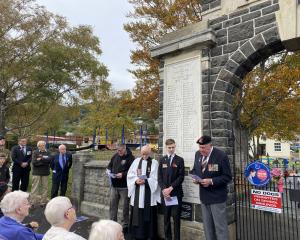Making the most of the warm autumn days, I recently took a stroll along the 1.5km stretch of Anzac Ave, beginning at Logan Park and heading south to Anzac Square at the Dunedin Railway Station.
Mindful of our national day of remembrance on April 25, I was struck by the lack of any public signifiers to indicate that this busy arterial route had any commemorative reference (other than by name) to the lives of New Zealanders lost in war.
This leafy avenue has had its share of controversy in recent times with the ongoing legal dispute over the commissioning of traffic lights at the Frederick St intersection, the poor health of a couple of elm trees near the Hocken Library and the tragic death of a cyclist at the Anzac Ave intersection with Castle St.
Anzac Ave owes its construction to the hugely successful New Zealand and South Seas International Exhibition, held in 1925 on the site formed from the draining of Lake Logan. This ''highway'', as it was referred to, formed a ceremonial linkage between the railway station and the gates of the exhibition complex, dominated by the Grand Court and the Great Dome of the festival hall.
As part of the construction of Anzac Ave, the bridge that crosses the Water of Leith was built. Progress demanded the demolition of tenement ''slums'' in the area, now largely forgotten but immortalised as John A. Lee's patch in his 1934 novel, Children of the Poor.
Today, unless pointed out, Anzac Ave's significance as a war memorial is fairly non-existent to the casual observer. Its major reference point is of course the elm trees that form a high-tunnelled canopy over much of the carriageway. These were planted in the 1920s to commemorate soldiers killed in World War 1 . Like the North Otago Memorial Oaks, it is believed the elms were once marked with plaques but these are now long gone.
Walking the length of the avenue, I looked to find any markers that might speak to me of the Anzacs who made the ultimate sacrifice.
The former art gallery in Logan Park - the only in-situ remnant of the 1925 Exhibition - was the recipient of a generous financial gift from Percy and Lucy Sargood in memory of their son Cedric who was killed at Gallipoli. Further on, the bridge over the Water of Leith bears the work of former students of the Dunedin School of Art - an assortment of ceramic bas-reliefs with at least one site-specific reference to the Anzacs.
On the Polytechnic's School of Veterinary Nursing building at the intersection with Albany St, an inconspicuous granite plaque and roll of honour remembers the former pupils of the original Albany St School who never returned from World War 1 .
And finally, at the southern end of the avenue lies Anzac Square, directly in front of the Dunedin Railway Station. Here I searched in vain for any war memorial that served as a reference point to the square that bears a name so solemnly protected. But all was not lost. As you approach the entrance to the railway station foyer, a striking Passchendaele plaque is dedicated to members of the New Zealand Railways killed in this battle and another World War 1 roll of honour for Dunedin railway staff appears just inside the foyer.
But let me return to the avenue's crowning glory, the elm trees - more then 90 of them, the originals and more recent plantings - that cover the stretch from Logan Park to the railway station. With autumn in full swing, the Anzac Ave elms have begun to shed their leaves, a metaphor perhaps for fallen soldiers.
Next year sees the World War 1 centenary programme, marking 100 years since World War 1 began on July 28, 1914. There will be many projects staged in New Zealand and overseas during the 2014-18 period of the commemorations. More than $17 million has been allocated through the Lottery Grants Board to fund the commemorations and I hope Dunedin is geared up to get a share of the funding to support projects in the city.
The World War 1 centenary programme would be an ideal opportunity to get the cultural and creative sector involved, groups like Transforming Dunedin, a community-based movement for the arts that last year attracted about 300 arts and cultural practitioners to a highly successful symposium that explored creative options for the city.
Dunedin has the creative talent to put forward proposals and projects to fully involve the community in commemorating the centenary, people like sculptor Stephen Mulqueen whose extensive visits to war sites in France, Belgium and Germany have influenced his workshop practice.
And this is where I want to put in a plug for Anzac Ave. Despite its pockets of industrial ugliness, sanctioned graffiti and the presence of lumbering logging trucks, this busy avenue - with its gracious elm trees in memory of Dunedin's inextricable links with Gallipoli, the Somme, Ypres, Messines and Passchendaele - deserves some renewed creative focus as Dunedin gets ready to mark next year's centenary of the beginning of World War 1.
- Tony Eyre is a Dunedin writer.












